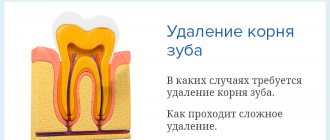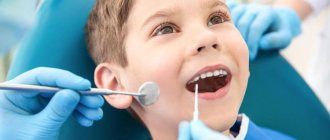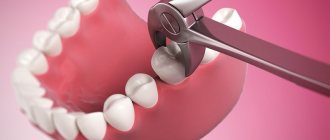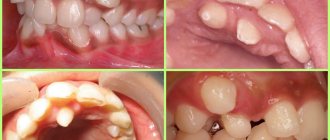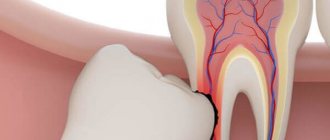Wisdom teeth often cause dental problems, the most serious of which is an atypical position. “Eights” can grow at an angle, be completely embedded in bone tissue, or only partially erupt.
With their crown, they can injure a neighboring tooth. When such situations arise, dentists recommend atypical wisdom tooth extraction. Timely surgery will help avoid injuries and the occurrence of carious inflammation. Specialists at the Profident Junior surgical dentistry clinic will perform the operation as quickly and painlessly as possible.
When is it necessary to remove an impacted tooth?
Despite millions of years of evolution, humans still continue to develop and improve. Our ancestors had massive jaws, and therefore they accommodated more teeth, which were adapted for biting and tearing food, as well as for chewing it. Now, due to changes in diet, the jaws have begun to shrink, and therefore sometimes there is simply not enough space for all the teeth. This is how impacted teeth appear, i.e. teeth, the rudiments of which formed in the jaw, but there was not enough space for them to erupt, and therefore they remained in the bone, never growing into the dentition.
Types of dystopia
Abnormal arrangement of primary teeth is rare; usually permanent teeth are susceptible to dystopia. They can be dystopic within the dentition or outside it, they can be deployed along a vertical axis, and have different inclinations. Depending on the position of the tooth, the following types of dystopia are distinguished:
- Vestibular - the tooth moves outward from the dentition to the vestibule of the oral cavity. Most often, incisors and canines are affected by this type of deviation. A person’s smile with dystopic fangs is commonly called a “vampire smile.”
- Mesial – the tooth moves forward along the dentition.
- Distal – deviation of the tooth back along the dentition.
- Oral: Lingual deviation – a tooth on the lower jaw is displaced towards the tongue. It is observed more often on incisors and premolars.
- Palatal deviation - a tooth on the upper jaw is shifted towards the palate. This dystopia is typical for central incisors.
- Supraposition - the lower jaw tooth is displaced vertically above the occlusal curve (the line that passes through the points of closure of the teeth).
Dystopia of impacted teeth, that is, unerupted teeth, is also diagnosed. Often this anomaly is characteristic of the third molars (wisdom teeth): they are located horizontally or obliquely in the jaw bone or in the gum tissue.
Sometimes an anomaly occurs such as dystopic supernumerary teeth - additional teeth that erupt outside the dental arch (in the palate, on the gums).
Impacted and dystopic teeth – is there a difference?
The standard assumption is that a person should have 32 teeth, but it is now common for people to have fewer teeth. The most common example is the absence of two or more eights in the dentition. At the same time, the computed tomogram shows that they are, in principle, there, but they are located deep in the jaw. There are other situations: individual units have partially grown, but not enough to be considered full-fledged teeth. Such teeth are called incompletely erupted or partially impacted.
In dental practice, there is another type of anomalies of eruption and position - dystopia. This is when the tooth has grown “to its full height”, but in the wrong direction - towards the brothers in front; to the right, towards the cheek, or to the left, towards the palate or tongue. In some cases, this state of affairs interferes with neighboring teeth and can cause various diseases in them, in others it harms the person himself, worsening the quality of chewing food, making it impossible to properly close the jaws, curving the entire dentition and causing pain.
In addition, incomplete eruption and dystopia are often combined with each other, and then the situation worsens so much that it leaves the dentist practically no choice - such an abnormal tooth must inevitably be removed.
Causes of dystopia
Dental dystopia develops under the influence of various factors, the main ones being:
- deviations in the normal growth of the jaw (delayed growth);
- discrepancy between the size of the teeth and the size of the jaw;
- partial adentia (absence of some teeth);
- deviations in teething;
- hyperdentia (supernumerary teeth);
- atypical anlage of tooth germs;
- significant discrepancy between the sizes of temporary and permanent teeth;
- macrodentia (increase in the size of the dental crown);
- abnormal arrangement of adjacent teeth;
- injuries of tooth buds;
- bad habits (hand biting, thumb sucking by children during sleep);
- early removal of baby teeth and lack of rational prosthetics;
- narrowing of the dentition;
- late loss of baby teeth;
- genetic predisposition;
- absence of a neighboring tooth or an antagonist tooth on the opposite jaw;
- odontogenic neoplasms (cysts, tumors).
Is an impacted tooth always subject to extraction?
No not always. There are a number of indications for the removal of impacted teeth in which surgical intervention cannot be avoided. These include cases:
- development of pulpitis or periodontitis in an impacted tooth. This applies to teeth that have not fully erupted. Due to the fact that they are difficult to clean and are often covered with a gingival hood, such teeth are more susceptible to caries and inflammatory processes. Considering their special position in the mouth and the extremely difficult access to them, there is no point in sanitizing impacted units, because In any case, treatment will be unsuccessful.
- swelling of the cheek due to the formation of pericoronitis - inflammation of the gingival fold covering an incompletely erupted tooth. Food often gets clogged under the hood, which is quite difficult to clean out with ordinary hygiene products, so the inflammatory process is quite common in such situations.
- formation of periostitis, or flux, against the background of caries or pulpitis of the impacted unit. If the process had formed around the “correct” tooth, then the doctor would have the opportunity to eliminate the inflammatory process either with the help of pharmaceuticals, or by making an incision in the gum and installing drainage into it. However, when it comes to impacted teeth, such measures are ineffective, so the patient has to say goodbye to the “troublemaker.”
- constant discomfort and pain due to the pressure of the unerupted unit on the nerves running along the jaw. In this case, the tooth can be absolutely intact and not interfere with the rest of its brethren.
- the need for orthodontic treatment to correct the bite. If an impacted tooth interferes with its neighbors, for example, moves them and causes them to crowd together, then this is a direct indication of removal. In addition, impacted units must be removed if they impede the movement of the remaining teeth in the dentition.
- preparing the oral cavity for prosthetics. If an impacted tooth cannot be “pulled out” using orthodontic methods and placed in the dentition in order to be used in the future as a support, for example, for a bridge structure, it is removed, because it only worsens the situation and reduces the quality of the treatment provided.
Please note: even if nothing bothers the patient and the impacted figure eight does not affect the general situation in the oral cavity in any way, a consultation with a dental surgeon and a computed tomography scan of both jaws is necessary. The doctor will be able to comprehensively assess the whole picture and draw conclusions about the advisability of removal. He will talk about the immediate and long-term consequences of removing an impacted wisdom tooth, and the prognosis of surgical treatment in relation to the patient’s orthodontic health.
It also happens that a person complains of headaches or clicking in the temporomandibular joint, but it turns out that the problem lies in abnormally erupted or incorrectly positioned third molars. Naturally, in such cases, the best solution would be to remove the problem teeth.
In what cases is a dystopic tooth removed?
As we have already figured out, a dystopic tooth is one that has completely erupted, but is located in a non-standard place for itself and thus changes the condition or location of neighboring teeth. Therefore, the following indications for removing a dystopic tooth help the doctor decide whether to leave it or not:
- presence of displacement of adjacent teeth;
- permanent injury to the oral mucosa, lips or tongue;
- stimulation of the development of cysts, inflammation or other pathological processes in surrounding tissues.
It is worth noting that removal is carried out only if it is impossible to correct the situation in any other way (for example, orthodontically) or if the patient does not agree to such measures.
How can you remove a tooth located deep in the jaw?
The doctor carefully prepares for the operation of removing an impacted tooth, because This is obviously a more complex manipulation. The less of the crown part has come out from under the gums, the more trouble there will be. It is no coincidence that they say: the most difficult thing is removing an impacted dystopic tooth. Not only does it need to be exposed and freed from the bone, but it also needs to be removed in such a way that no small parts remain in the jaw. But first things first.
Before surgery, the patient is always sent for a CT scan. The information from this examination allows the doctor to understand the location and depth of the tooth, whether it has contacts with neighboring units, the location and shape of the roots, proximity to the nerves of the jaw and other important anatomical structures. Only after this can you plan the course of the operation, the type of anesthesia, the required instruments and auxiliary equipment.
A few words about pain relief methods when removing impacted teeth. In general, they are not much different from those with simpler and less labor-intensive removals. It is believed that these operations are somewhat more traumatic and take a long time. Not at the Refformat clinic. With us you will quickly part with your wisdom teeth. Therefore, you should not be scared, but if you are very scared of dentists in general, we can offer the option of treatment in your sleep. You can find out what this method is here and here.
The patient does not require special preparation, however, in cases where the operation will be performed under sedation, he should first undergo a small set of tests and consult with a therapist.
After the onset of anesthesia, an incision is made in the gum exactly above the place where the causative tooth lies, which provides access to the periosteum and jaw bone. The dissected tissues are carefully pulled apart. Then they proceed according to one of the options - either they drill out the bone around the tooth in order to remove it entirely, or the tooth is divided into parts with burs and removed in parts. The method of removing impacted and dystopic teeth in some cases involves filing down the crown part, and then dividing and extracting the roots. If a nerve passes near the coronae, a coronotomy can be performed - removing only the supragingival part of the tooth, while the roots will remain in place.
The operation ends with returning the soft tissue flaps to their place and suturing the wound with nylon or self-absorbing threads. To prevent postoperative complications, the doctor may inject an anti-inflammatory drug into the transitional fold, as well as prescribe antibiotics for up to 5 days.
If the sutures were applied with synthetic threads, they are usually removed after a week and a half. There is no need to remove catgut sutures.
Atypical extraction of the 8th tooth, complicated at the Profident Junior clinic
Complex and atypical tooth extractions at the Profident Junior clinic are performed using the latest equipment and reliable instruments. Specialists use European techniques that make it possible to painlessly and quickly perform any type of surgical operation, including the removal of a wisdom tooth with cutting of the gums.
Atypical tooth extraction, depending on the complexity, is performed using local or general anesthesia. The staff ensures sterilization and cleanliness to ensure safety during treatment.
You can find out the price for atypical wisdom tooth extraction at the Profident Junior clinic by scheduling a consultation.
This can be done not only by phone, but also online by filling out a simple form on the website. Here the uniform is blue.
Profident Junior uses all methods of atypical tooth extraction. Dental surgeons have the necessary skills and constantly improve their qualifications.
How does the postoperative period proceed?
After removal of an impacted wisdom tooth, minor pain and swelling in the cheek are quite natural. They usually go away 2-3 days after surgery. To reduce these phenomena, the doctor prescribes painkillers, and ice can be applied to the cheek on the extraction side. Incomplete opening of the mouth and discomfort in the throat when swallowing and chewing are also considered normal, which goes away on its own after 3-4 days.
But severe pain after removal of an impacted wisdom tooth is a reason to visit the doctor who performed the operation, because
this may be a sign that the wound needs additional treatment. Another reason that should force you to immediately see a doctor is an increase in body temperature above 37.5°. To the list of posts

